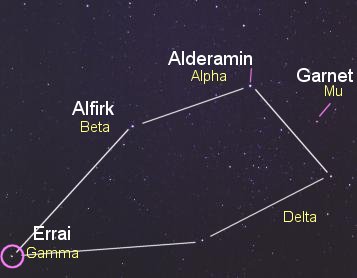 Errai (Gamma Cephei) is the among the visually brightest stars to
host a planet, and also has a low mass companion with a relatively
small orbit.
Errai (Gamma Cephei) is the among the visually brightest stars to
host a planet, and also has a low mass companion with a relatively
small orbit.
THE PLANET
The circle shows the location of the class K2 giant star Errai
(Gamma Cephei) in the constellation Cepheus. The planet, with a mass of at least 1.85
times that of Jupiter, is one of the few known to lie within a double-star system, and orbits
the main star Gamma Cephei A with a period of 2.47 years at an
average distance of 2.05 Astronomical Units (307 million
kilometers, 191 million miles), or 2.05 times the distance between
the Earth and the Sun. The orbit is only slightly eccentric.
Suggestions for the planet's existence go back to 1992. The planet
is in a double star system whose separation is comparable to the
size of our own planetary system, and shows that planets can be
formed and survive in relatively close binary systems. An estimate
of the inclination of the system from the stellar rotation gives a
true planetary mass between 3 and 16 Jupiters.
|
 Errai (Gamma Cephei) is the among the visually brightest stars to
host a planet, and also has a low mass companion with a relatively
small orbit.
Errai (Gamma Cephei) is the among the visually brightest stars to
host a planet, and also has a low mass companion with a relatively
small orbit.
 Errai (Gamma Cephei) is the among the visually brightest stars to
host a planet, and also has a low mass companion with a relatively
small orbit.
Errai (Gamma Cephei) is the among the visually brightest stars to
host a planet, and also has a low mass companion with a relatively
small orbit.